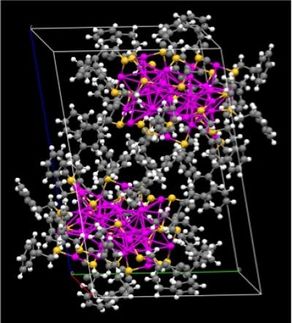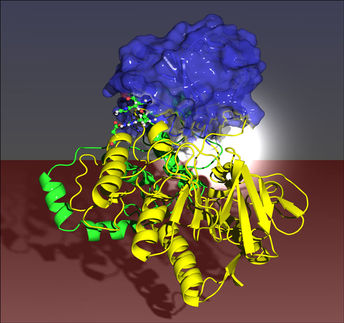Pairing Nanoparticles with Proteins
New ways to tag, engineer molecules for energy conversion, drug delivery, and medical imaging
In groundbreaking research, scientists have demonstrated the ability to strategically attach gold nanoparticlesto proteins so as to form sheets of protein-gold arrays. The nanoparticles and methods to create nanoparticle-protein complexes can be used to help decipher protein structures, to identify functional parts of proteins, and to "glue" together new protein complexes. Applications envisioned by the researchers include catalysts for converting biomass to energy and precision "vehicles" for targeted drug delivery.
"Our study demonstrates that nanoparticles are appealing templates for assembling functional biomolecules with extensive potential impact across the fields of energy conversion, structural biology, drug delivery, and medical imaging," said lead author Minghui Hu, a postdoctoral student working with James Hainfeld, Raymond Brinas, Luping Qian, and Elena Lymar in the Biology Department at Brookhaven Lab.
In the field of energy conversion, scientists have been searching for efficient ways to convert organic fuels such as ethanol into electricity using catalytic electrodes. But making single layers of densely packed enzymes, the functional part of such catalytic electrodes, has been a challenge. This new research shows that precisely engineered gold nanoparticles can be used to "glue" enzymes together to form oriented and ordered single layers, and that these monolayers are mechanically stable enough to be transferred onto a solid surface such as an electrode.
For this research, the scientists attached gold nanoparticles to an enzyme complex that helps drug-resistant tuberculosis bacteria survive, which has been studied by Brookhaven Lab biologist Huilin Li. The researchers suggest that gold nanoparticles might also be tailored to inactivate this enzyme complex, thereby thwarting drug-resistant TB - a research avenue they may explore in future studies.
In another part of the study, the researchers used proteins found on the surface of adenovirus, a virus that causes the common cold. Previous studies by Broookhaven's Paul Freimuth have characterized how this virus binds to the human cells it infects, and have suggested that modified forms of adenovirus could be used as vehicles to deliver drugs to specific target cells, such as those that make up tumors.
One key to this approach would be to enhance strong binding to the target cells. Toward that end, Hu and Hainfeld's group attached multiple viral proteins to the gold nanoparticles. Such constructs should have increased binding affinity for target cells and their larger size should extend blood residence time for improved drug delivery.
In another application, this new research showed that gold nanoparticles can enhance scientists' ability to decipher the structures and functionally important regions of protein molecules - the workhorses that carry out every function of living cells and whose dysfunction often leads to disease. With added nanoparticles, the "signal-to-noise ratio" and resolution of an imaging technique known as cryo-electron microscopy were significantly increased. This method might enable analysis of small biological macromolecules and complexes that are currently intractable to analyze by cryo-electron microscopy or x-ray crystallography.
Throughout this work, the biggest challenge was to synthesize size-controllable nanoparticles coated with organic molecules designed to react with specific protein sites. Hu explains the steps: "First, we design the specific interactions between gold nanoparticles and the proteins by coating the gold nanoparticles with functional organic molecules using a biocompatible linker. Then we add a genetically engineered sequence of peptides, called a "tag," to the protein molecule, which acts as the binding site for the gold nanoparticles. Finally, we incubate the nanoparticles with the protein solution to allow the nanoparticles and proteins to bind, transfer the solution onto a transmission electron microscopy grid, and analyze the complexes using state-of-the-art electron microscopes."
Original publication: Angewandte Chemie 2007.
Most read news
Topics
Organizations
Other news from the department science
These products might interest you

NANOPHOX CS by Sympatec
Particle size analysis in the nano range: Analyzing high concentrations with ease
Reliable results without time-consuming sample preparation

Eclipse by Wyatt Technology
FFF-MALS system for separation and characterization of macromolecules and nanoparticles
The latest and most innovative FFF system designed for highest usability, robustness and data quality

DynaPro Plate Reader III by Wyatt Technology
Screening of biopharmaceuticals and proteins with high-throughput dynamic light scattering (DLS)
Efficiently characterize your sample quality and stability from lead discovery to quality control

Get the chemical industry in your inbox
By submitting this form you agree that LUMITOS AG will send you the newsletter(s) selected above by email. Your data will not be passed on to third parties. Your data will be stored and processed in accordance with our data protection regulations. LUMITOS may contact you by email for the purpose of advertising or market and opinion surveys. You can revoke your consent at any time without giving reasons to LUMITOS AG, Ernst-Augustin-Str. 2, 12489 Berlin, Germany or by e-mail at revoke@lumitos.com with effect for the future. In addition, each email contains a link to unsubscribe from the corresponding newsletter.


























































